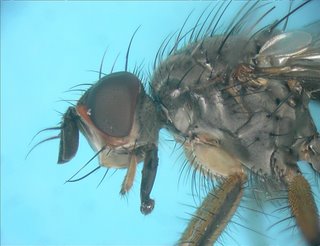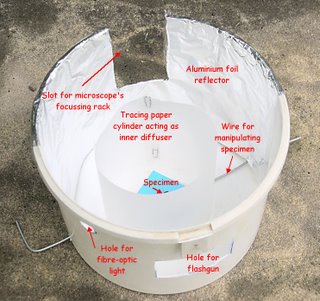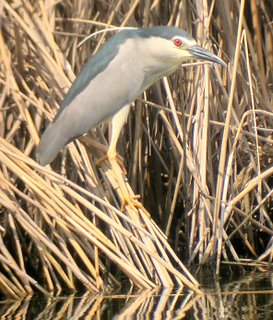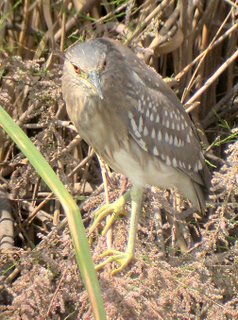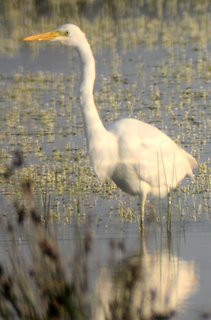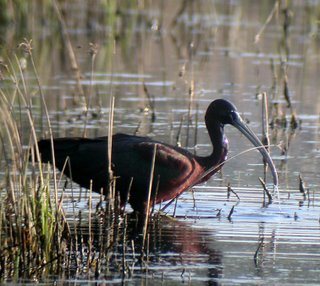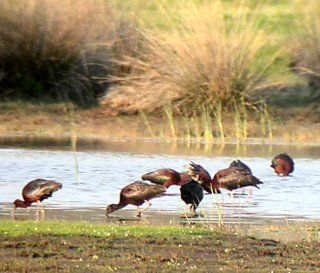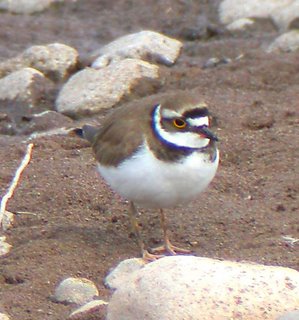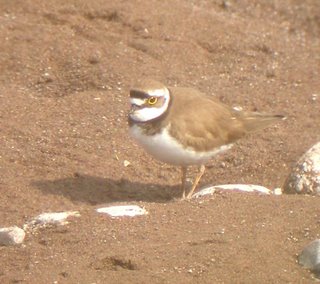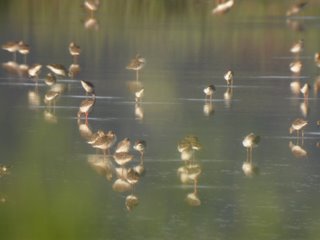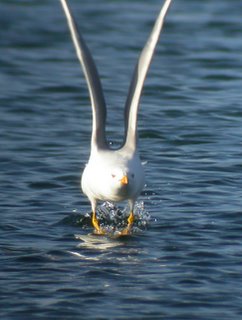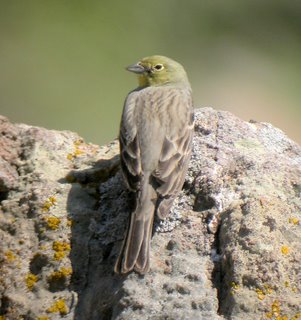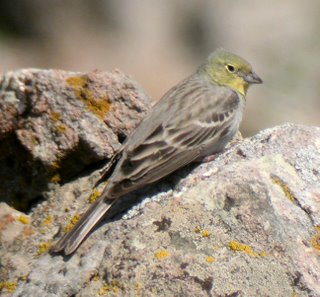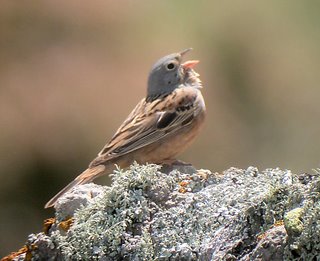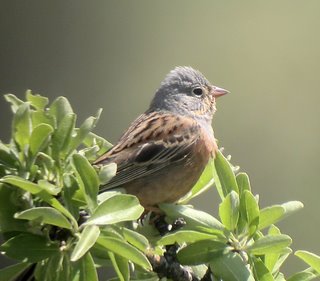ItinerayFive of us flew to Athens from Luton on EasyJet on the evening of Saturday 8th April 2006. We had to stay a night in Athens because the flights to Mytilini are early moring.
Sunday 9th was a very early start. Up at 3:30 to get back to the airport by 5am for a 6am flight. We picked up a hire car at Mytilini and were at out apartment in Skall Kalloni in time for a walk round the pool and breakfast in a cafe.
The daily routine during the week was:
- up at 7:30 am for a walk round Skala Kalloni pool to see what had arrived, ending at the bakery for bread for the day and some breakfast
- out about 9:30 for the day
- back around 5pm for tea/cold beer then to Kalloni salt pans
- dark around 7:30pm - find a resturaunt for an evening meal
The return journey was more convenient. We birdwatched for much of Sunday 16th, with the flight to Athens not until 16:40, then the return to Luton at 20:50.
WeatherNot really tee-shirt weather except the Sunday we left. Two very windy days and one wet day. Quite cool.
MigrationThis week was a bit earlier than we would ideally have liked. The following week, or the last week of April would have been better. But one of the party is a School Teacher, so we had to go during the School Easter Holiday.

It was a wet winter this year so there was plenty of water about. Skala Kalloni pool was full and there were pools on the fields around the Kalloni Salt Pans. Consequently, there was plenty of water for waders, wildfowl and herons.
Consequently, we did quite well for waders and wildfowl, with winter visitors like Teal, Pintail, Shoveller, Tufted Duck and Mute Swan still present. But we were too early for many migrants. Shrikes just started turning up during the week. We had the first of the marsh terns (Whiskered), but no White-winged black had arrived and missed Red-footed falcon and many others that would have been due over the next week or two.
BirdsLittle GrebeDaily on Skalla Kaloni pool, otherwise only on the Inland Lake on Monday 10th.
Great Crested GrebeMost days 1 or 2 on the sea from Skala Kalloni beach. Also singles at the mouth of East River on Sunday 9th and Thursday13th and on the sea off Kalloni Salt Pans on 14, 15 and 16th. Mostly in summer plummage, but one of the birds off Skala Kalloni had not yet changed.
Black-necked GrebeTwo in summer plummage off the mouth of the East River on Sunday 9th and Thursday13th and one also in summer plummage on the sea off Kalloni Salpt Pans on 14th and 15th.
 Mediterranean Shearwater
Mediterranean ShearwaterWednesday 12th was very windy all day with a strong SW so we visited Agios Fokas - the headland on the east side of the entrance to the Kallonis inlet at the extreme south of the island. It was more like the Atlantic crashing in on the coast of Cornwall than the Mediterranean! Parties of Shearwater were passing more or less continually, all heading westwards.
CormorantSeen most days over the sea. For example, usually several sitting on the shingle bar at the mouth of the East River or on the jetty at the Kalloni Salt Pans.
ShagOne swimming around in the harbour at Sigri on Tuesday 11th. It eventually swam out of the harbour mouth then took off and flew out towards the offshore island to the east.
(White Pelican)
The tame bird was around the harbour at Skala Kalloni - although we only saw it on one evening. Where does it spend the rest of its time?
 Bittern
BitternWest River, Monday 10th. We drove down the track on the west side of the river and surprised this bird right out in the open in a small, muddy pool beside the track. It crouched down stock still pointing its head vertically upwards about 1m infront of the vehicle. After a while it clearly realised its cover was blown and snook very slowly, still crouching, off along the track. I've never seen a bird look more embarassed! The photo was taken using the camera's standard zoom only! One at Kalloni Salt Pans on Sunday morning 16th - also a very close view. Presumably the same bird was reported in the same area on the previous two evenings although it was not seen by us.
Little BitternOne in the base of tamerisks on the edge of Skala Kalloni pool on 9th, 10th and 15th. Kepping very still and difficult to pick up. Only visible from the beach road looking back towards the hotels. We were probably too early to see this species in the abundance I remember from my previous visit.
Night Heron4-6 at the Inland Lake on 10, 14 and 15th. 4 roosting in tamerisks at Skala Kalloni pool on Tuesday 11th, but only 1 the following morning.
 Squacco Heron
Squacco Heron3-5 seen daily at Skala Kalloni pool. Also on the East River and Kalloni Salt Pans.
Little EgretSeen daily on East and West Rivers, Skala Kalloni pool and the Kalloni Salt Pans.
Great White EgretSeen daily at Kalloni Salt Pans where at least 2 birds were present. Also singles at Derbyshire, Skala Polichintos and one flying over Skalla Kalloni on the morning of Sunday 16th.
Grey HeronSeen every day, mostly at Kalloni Salt Pans where up to 8-10 birds present. Also East and West River, Parakila, Vatera River and Skala Kalloni pool.
 Purple Heron
Purple HeronSeen most days especially on the East River where up to 3 were seen together. Single at Skala Kalloni pool most mornings also Inland Lake. Two flwe in off the sea to Makara beach on Saturday 15th.
Black StorkOne soaring over the East River on Sunday 9th and over Kalloni Salt Pans on Wednesday 12th. 7 seen over about a half hour period over the ridge with the radio masts north of Napi all heading northwards. 2 on the fields east of the salt waorks at Kalloni Salt Pans on Sunday 16th.
White StorkPair on a nest on Papiana church were visible from the apartment balcony (although it took us several days to notice them!). These birds, either on the nest, or flying too and fro were the only White Storks we saw.
Glossy IbisLarge numbers seen with a flock estimated over 200 high above Kalloni Salt pans on the evening of Wednesday 12th. About 100 dropped into Skala Kalloni pool each evening as it approached dusk and could be watched arriving in parties of up to 40 from the apartment balcony. Always lots present on Skala Kalloni pool and the various pools in the fields around the Kalloni Salt Pans.
Greater FlamingoUsual flock at Kalloni Salt Pans. The salt pans at Skala Polichintos were almost completely dry with only a couple of pans in the middle holding very limited water and only 6 Flamigos were present.
Mute SwanOne bird was present all week in the flooded fields next to the Kalloni Salt Pans. A second bird joined in on the last weekend (15th & 16th).
Ruddy ShelduckUp to 30 seen on the fields to the east of the salt works at Kalloni Salt Pans - always at a distance, but present evry evening. Otherwise singles were seen at Derbyshire and Skala Polichintos.
Shelduck2 at Kalloni Salt Works on Monday 10th and one at Skala Polichintos on Wednesday 12th.
Teal2 males and 1 female on Skala Kalloni pool when we arrived. Only one drake by Tuesday 11th and not seen thereafter.
PintailAbout 6 (all drakes) present all week on pool in the fields to the east of the salt works at the Kalloni Salt Pans in very smart summer plumage.
 Garganey
GarganeyBy far the commonest duck and present at all the wetlands we visited with considerable numbers in the various pools on the fields around the Kalloni Salt Pans. On the evning of Saturday 15th a flock estimated at 60 flew in and landed on the sea off the Salt Works. Around 6-8 on Skala Kalloni pool each morning.
ShovellerAbout a dozen on pools on fields east of the salt works at Kalloni Salt Pans all week (with Pintail). Also a pair flew off from Skala Kalloni pool on Sunday moring (16th).
Tufted Duck2 drakes on Skala Kalloni pool for the first two mornings. Reduced to one by Tuesday and not seen again thereafter.
Short-toed EagleSeen daily mainly inland, for example Potamia Valley and Napi, but also from the Kalloni Salt Pans and Derbyshire pools.
Marsh Harrier1f over West River Sunday 9th, 1m Kalloni Salt Pans Monday 10th, 1 Faneromeni ford Tuesday 11th, 1f over Skala Kalloni pool Wednesady 12th.
Hen HarrierVery good view of a ring-tail at the salt works, Kalloni Salt Pans evening of Sunday 9th. Distant ring-tail Faneromeni ford Tuesday 11th. Ring-tail overhead being mobbed by a hoody at Inland Lake Saturday 15th.
Montagu's HarrierDistant male at heading towards East River from Kalloni Salt Pans on Sunday 9th and good views of a male at the same place on Saturday the 15th and two females on Sunday 16th.
SparrowhawkSeen almost daily, especially in Inland Lake - Potamia area, but also pine woods near Derbyshire and ridge north of Napi.
Common BuzzardSeen almost daily usually inland over hilly terrain such as Eressos and Napi.
Long-legged BuzzardSeen almost daily especially Inland Lake - Potamia area and around Napi.
Booted EaglePale phase bird in Potamia Valley Monday 10th.
Lesser KestrelSigri - Faneromeni area on Tuesday 11th. A single male watched for some time from road coming in to Sigri. Many sightings with up to 3 together around Faneromeni.
Common KestrelOne at Kalloni Salt Pans on Wednesday 12th and two around the ridge north of Napi on Thursday 13th.
HobbyOne Potamia Valley Monday 10th.
Elenora's FalconOne from road cutting just north of Napi on Thursady 13th.
PeregrineOne around the island just off the beach at Makara on Saturday 15th. It put up all the gulls which presumably breed on the island, went high above them and stooped.
QuailAt least two calling at East River on Sunday 9th.
Water RailVery good views of two birds at the western end of Skala Kalloni pool on Monday 10th. Heard in the same area on 11th and 16th.
Spotted CrakeVery good views of one witha Little Crake near the east end of Skala Kalloni pool on Tuesday 11th and two birds seen flying briefly at the west end of the pool on 14th.
 Little Crake
Little CrakeSeen daily at Skala Kalloni pool with up to four sightings in one circuit of the pool. One male bird with a damaged leg, giving it a distinctive limp, was seen several times towards the east end of the pool. Also several seen at Inland Lake.
MoorhenSeen daily at Skala Kalloni pool also Parakila, Inland Lake and Kalloni Salt pans.
CootSeen daily at Skala Kalloni pool also Parakila, Inland Lake and Kalloni Salt pans.
 Black-winged Stilt
Black-winged StiltAbout 3-4 pairs on Skala Kalloni pool and many at Kalloni Salt Pans. Also on the pools at Derbyshire.
AvocetAbout 150 on the Kalloni Salt Pans daily.
Stone Curlew2 seen sitting on bunds between the pans at Kalloni Salt Pans on 9th, 14th qand 16th - though probably present all the time if you looked carefiully enough! 1 in fields next to Skala Polichinitos on Wednesday 12th.
 Collared Pratincole
Collared Pratincole6 on Kalloni Salt Pans on evening of Saturday 15th. At least two were still present the following morning when we got much better views.
Little Ringed Plover2-3 pairs present on the East River with what seemed like territorial behavior and/or courtship on Saturday 15th. Also West River and Kalloni Salt Pans.
Ringed PloverOne West River on Monday 10th and up to 5 at Kalloni Salt Pans on 12th, 14th and 15th (with Kentish Plover).
 Kentish Plover
Kentish Plover2-3 pairs at West River on Monday 10th at Kalloni Salt Pans most evenings.
LapwingOne on a bund dividing the pans at Kalloni Salt Pans on Friday 14th.
Little StintSmall waders were surprisingly scarce. Just two stints seen with other waders on flooded fields beside the Kalloni Salt Pans on Sunday 9th.
Dunlin3 on a sand-bar in one of the pans at Kalloni Salt Pans on Monday 10th.
RuffVery large flock estimated at around 350 on the Kalloni Salt Pans all week. Smaller numbers usually feeding with other waders on the pools in fields around the salt pans. A few also present on Skala Kalloni pool on several morning.
Common SnipeOne on Skala Kalloni pool on Monday 10th.
Black-tailed GodwitFlock of about 35, mostly in summer plumage, at the Kalloni Salt Pans in the earlier part of the week - sometimes feeding in the field pools, sometimes on the pans with Avocet. These seemd to have gone later in the week but one individual with only one leg remained and was present on the pool in fields to the east of the Salt Works just about every day.
Curlew2 flying Kalloni Salt Pans on Sunday 9th. 1 at West River on 10th.
Spotted RedshankJust one, still in winter plumage, at Kalloni Salt Pans seen most evenings generally with Greenshank and Marsh Sandpiper flock.
Marsh SandpiperMany present all week at Kalloni Salt PAns, generally in a flock with Greenshank. Some other birders claimed as many as 30-40 present, but we saw no more than 10-12 and usually fewer. Because they kept to the deep-water pans at the north of the site it was very hard to get a good view!
GreenshankAbout a dozen on the Kalloni Salt Pans most evenings with more on the various pools in the fields around the pans. Also singles on Skala Kalloni pool on 13th and 14th and on the East River on 14th.
Green SandpiperOne on the East River regularly - usually near the road bridge, but also seen near the river mouth.
Wood SandpiperAbout the commonest wader and seen at all the wetland areas we visited. 4-10 present most days on Skala Kalloni pool, generally a small flock on the East Riverna d always many on the pools in fields around the Kalloni Salt Pans.
 Common Sandpiper
Common SandpiperOne seen several times around the mouth of East River on 9th, 13th and 14th. One at Kalloni Salt Pans on 10th (with Kentish Plaver) and one at Skala Kalloni pool on 16th.
Mediterranean Gull7 with other gulls on gravel bar at mouth of East River on Sunday 9th.
Black-headed GullSeen regularly around the pools to the east of the salt works at Kalloni Salt Pans with up to about a dozen birds, all still in winter plumage. Also two at mouth of East River on 13th.
Yellow-legged GullThe commonest gull and seen regularly just about anywhere. Even inland in dry, rock terrain there were generally gulls soaring in thermals.
 Gull-billed Tern
Gull-billed TernParty of 7 on an island in a pan at Kalloni Salt Pans on Monday 10th.
Caspian Tern2 hunting up and down the West River on Monday 10th. These were reported by other birders on several days later in the week so they were probably sticking around the same area.
Common TernSeen daily off the beach at Skala Kalloni and around the Kalloni Salt Pans. Generally a few sitting around on the gravel bar at the mouth of the East River and flying up and down both East and West Rivers.
Little TernFirst seen over Kalloni Salt Pans on Wednesday 12th, by the weekend there were many present.
Whiskered Tern3 at Kalloni Salt Pans on Friday 14th, on Saturday there were abou 30 which were still present on Sunday.
Feral PigeonAll towns and villages.
Collared DoveExtremely abundant around all human habitation.
Turtle DoveHeard in the groge on the road to Ipsilou on Tuesday 11th and in the woods on the ridge north of Napi on 16th.
(Barn Owl)
Apparently still nesting in one of the "chimmneys" on the disco in the centre of Skala Kalloni although said not to be emerging until very late (midnight). A Swedish birder stayed up and saw them come out. Another birder saw one heading out towards the East River shortly after dusk from the same area. Last time we came we had an apartment right next to the disco and saw the Barn Owls regularly so its nice to know they are still about.
Scops OwlRegularly calling around our apartment on the notrthern fringe of Skala Kalloni by the time we were returning from an evening at a resturaunt - say 11ish. On the first night, at least two were calling and a bird was sitting in the tree outside the apartment - lit up by the floodlights. It flew up to the roof of the building and could just about be seen. This one did not call, so we thought it might be the female.
Little OwlPair resident in the goat-shed immediately infront of our apartment and regularly to be seen sitting on the rooves of various outbuilding or posts and stacked wood roundabout.
SwiftPresent in vast numbers in all the towns and villages. Many with hirundines over Skala Kalloni pool every day.
Alpine SwiftOne over Kalloni Salt Pans 9th, many over Inland Lake - Potamia area on 14th and 15th. Over Mesotopos area on 15th.
KingfisherOne on West River on 10th. One in the harbour at Sigri on 11th.
HoopoeAlmost the first bird we saw on arriving at our apoartment in Skala Kalloni on Sunday 9th. 3 at mouth of East River the same day and again one on a beach in the East River on 14th. Heard ridge above Napi on 13th and 16th and gorge on road to Ipsilou on 11th.
Middle Spotted WoodpeckerSurprisingly, only seen twice. One in an olive grove near Faneromeni on 11th gave us very good views. Another was being very noisy, but not very visible in the woods on the ridge north of Napi on 13th.
Short-toed LarkParty of about 10-12 on "sand dunes" next to the shore at the eastern end of Kalloni Salt Pans on the evening of Monday 10th. Although we searched this area almost daily for these and Red-throated Pipit (which we didn't see, but a single bird was reported on 12th), we didn't see them again.
Crested LarkVery abundant everywhere. Seen every day.
SkylarkOne singing over fields next to apartments early morning on Monday 10th.
WoodlarkHeard at Ipsilou on Tuesday 11th and Napi on Thursday 13th.
Sand MartinAmongst the hirundines over Skala Kalloni pool most mornings. Not noticed anywhere else.
Crag MartinIn the gorge on the road to Ipsilou on Tuesday 11th. A pair watched at two different spots apparently investigating cliff overhangs, presumably looking for nest sites.
SwallowSeen daily around buildings almost anywhere.
Red-rumped SwallowMany with other hirundines (especially House Martins) over a field beside the East River on Sunday 9th. This field was also full of Yellow Wagtails so it is likely that some sort of mass emergence of insects was taking place. Also in the gorge on the road to Ipsilou on Tuesday 11th and at Kalloni Salt Pans on Saturday 15th.
House MartinAbundant around human habitation everywhere on the island. Many constructing nexts around Skala Kalloni. Frequently seen collecting mud from roadside puddles.
Tree PipitOne on damp fields behinnd Skala Polichintos salt pans on Wednesday 12th. We spent a long time deciding the identity of this bird. It is surprising that when several people view the same bird how different the descriptions can be!
 Yellow Wagtail
Yellow WagtailVery abundant on damp fields and the edges of any of the wetlands. in a confusing variety of forms. Black-headed (
Motacilla flava feldeggi) seemed to be dominant, followed by Blue-headed (
M. f. flava), with Grey-headed (
M. f. thunbergi) also present, but many intermediates. Black- and Blue-headed males in good plumage are amazing!
 White Wagtail
White WagtailSurprisingly few seen: East River on the 9th; fields next to Skala Polichinitos salt pans on 12th; outside the apartments on 15th.
WrenHeard a few times in more upland woodland situations. Gorge on the road to Ipsilou on Tuesday 11th, along north coast on 13th and in pine woods on the ridge north of Napi also on 13th.
NightingaleOne was singing every morning from hotel garden next to Skala Kalloni pool, but it wasn't until later in the week that they became more prominent elsewhere. By the second weekend they were singing all over the place.
Whinchat3 on a fence in fields next to Skala Polichinitos salt pans on 12th.
StonechatPair near Faneromeni beach on Tuesday 11th.
Isabelline WheatearIpsilou Tuesday 11th beside the road going up to the monastry. One on the fields next to Skala Polichinitos salt pans. One (with Northern Wheatear and Rock Thrush) at road curring just north of Napi on 13th.
Northern WheatearSeen several times at the coast such as Kalloni Salt Pans and Skala Polichinitos, but also inland at Ipsilou on 11th, at road curring just north of Napi on 13th and Apothikes on 15th.
 Black-eared Wheatear
Black-eared WheatearSeen every day both inland and near the coast, both in open, rocky terrain and also open wooded areas. Often seen on roadsides whilst travelling.
 Rock Thrush
Rock ThrushOne (with Northern and Isabelline Wheatear) at road curring just north of Napi on 13th.
Blue Rock ThrushPotamia Valley on 10th; gorge on the road to Ipsilou and at Ipslou itself on 11th and headland south of Molivos on 13th.
BlackbirdSeen every day in gardens and woodlands.
Song ThrushOne singing in Potamia Valley on 10th.
Cetti's WarblerAbundant in all wetland areas.
Sedge WarblerMany singing in reedbeds at Skala Kalloni pool. Also East River and Kalloni Salt Pans.
Reed WarblerOne at Skala Kalloni pool on Monday 10th.
Great Reed WarblerFirst heard at Skala Kalloni pool on Tuesday 11th and again on 15th and 16th. Two singing at mouth of East River on 14th and at Inland Lake on 15th.
Subalpine WarblerThe commonest
Sylvia warbler in all scrub habitats, but often difficult to see!
Ruppell's WarblerHeadland south of Molivos on on Thursday 13th. Took quite a lot of percieverence, but all got good if distant views.
Orphean WarblerGorge on the road to Ipsilou on 11th, Napi and Molivos on on 13th and Makara beech on 15th.
Lesser WhitethroatVery close view of one at Faneromeni on 11th. At least one singing at ridge north of Napi on 13th and 16th. One in lower Potamia Valley on 14th.
WhitethroatOne at Inland Lake on 10th. One singing near East River on 13th and one singing in Lower Potamia Valley on 14th.
Blackcap2 males together in a tree near Faneromeni on 11th. Female seen in wooded slope of ridge north of Napi on 13th.
Bonelli's WarblerSinging in oak woods in Potamia Valley near "Two Bridges" on Monday 10th.
ChiffchaffOne singing in hotel garden next to Skala Kalloni pool on morning of Sunday 16th and at least another one singing in pine woods on ridge north of Napi on the same day - although this was more of a "chaff-chaff".
Collared FlycatcherMale on the northern slope of Ipsilou on 11th and another in pine wood close to Derbyshire on 12th.
Pied FlycatcherMale near Faneromeni on Tuesday 11th.
Long-tailed TitOne in gorge on road to Ipsilou on 11th and several heard in pine woods on ridge north of Napi on 13th.
 Sombre Tit
Sombre TitDeciduous woodland on slopes of ridge north of Napi on 13th (at least two birds). Devil's Bridge - pair with a nest in a roadside hollow meatal fence post. One on a rock on a bare hillside near Makara on the same day.
Blue TitCommon in woods and gardens. Seen most days.
Great TitVery common in woods and gardens. Seen every day.
Krüper's NuthatchPair in pine woods near Derbyshire on Wednesday 12th. This is the area marked as "Track through scrub and rocks" starting by "Small army building" just south of "Derbyshire (rock outcrop) on Map No. 5 in Richard Brooks book. Walking for a way up this track takes you to a series of large, burried military bunkers. The Krüper's Nuthatch were in the area of mature pines around and in front of the first two bunkers. The female was watched for some time exploring the trunks of pine trees. She was then joined by a male - with much calling and chasing round and round the trunk of a large pine near to ground level. Presumably courtship behaviour.
 Western Rock Nuthatch
Western Rock NuthatchIpsilou on 11th, road cutting just north of Napi on 13th - several seen and more heard in the area. Lower Potamia Valley on 14th on rocky slope not far from the Inland Lake. Apothikes area on 15th - several seen and more heard.
Red-backer ShrikeA single male in fine plumage in the lower Potamia Valley on Friday 14th.
Woodchat ShrikeIt seems that shrikes were only just starting to arrive during the week we were there. We first saw a single Woodchat in the Lower Potamia Valley on Monday 10th, but by mid-week we were seeing them reasonably often and on the last Sunday, 3 birds were visible at the same time on a wooded slope near Napi. A Masked Shrike was also reported in the area of the Inland Lake, but we didn't find it despite several attempts.
JayReasonably frequent in wooded areas especially Potamia Valley and in the pine woods on the ridge north of Napi.
JackdawA few around Sigri on 13th and a large flock of about 50 at Makara beach on 15th.
Hooded CrowVery frequent just about everywhere.
RavenSeen most days, mostly inland, but a bird was soaring very highand calling over the Kalloni Salt Pans on the evning on Sunday 9th.
 House Sparrow
House SparrowExtremely abundant around all human habitation.
Spanish SparrowOn a previous visit, they had been nesting in trees along the coast road in Skala Kalloni, but we did not find any on this occasion, although they were nesting in the underside of the Stalk's nest on the church roof in Papiana. However one was perched in a tamerisk on Skala Kalloni pool on the morning of Thursday 13th together with several House Sparrows. Two large flocks were seen: one beside the East River on the 9th and another in a field near Faneromeni on 11th.
Rock SparrowAt the site described by Richard Brooks (page 66) as roadside culvert 3km beyond Agra. A single bird was seen, but others were calling around a concrete goat-shed with a corrugated iron roof above the road. A very underwhelming bird! The best way of finding them seems to be to listen for the call - which is very un-sparrow-like. But beware, the call of Cretzschmar's Bunting is very sparrow-like and confused us mightily!
ChaffinchCommon everywhere, but especially in pine woods at higher altitudes.
SerinSurprisingly, seen only once when one was found singing in a roadside clearing in the pine woods on the ridge north of Napi on Thursday 13th.
GreenfinchMostly seen in gardens in Skala Kalloni.
GoldfinchSeen every day in all sorts of conditions from gardens in Skala Kalloni to bare rocky hillsides around Apothikes.
Cirl BuntingSeen and heard reasonably frequently on dry, rocky hillsides usually where there were isolated trees or bushes. Usually singing from the top of a bush or a roadside wire, but occasionally from the top of a rock.
Cinereous BuntingFound very easily at Ipsilou on Tuesday 11th. Almost the first birds we saw and heard on heading up the tracktowards the monastry. But it was a very winday day, and most of the singing birds were on the north side of the hill were it was sheltered from the wind. At least five singing from trees and bushes here. Also seen at the same site as the Rock Sparrow (Richard Brooks' roadside culvert 3km beyond Agra) where at least two males were singing (together with Cretzschmar's and Cirl bunting), one from an isolated tree and the other from a large rock.
Cretzschmar's BuntingVery abundant on dry, rocky slopes throughout the interior o the island. Once you have learned the song (bit like a truncated Yellow-hammer) you can hear them whenever you are driving through suitable habitat - and Lesvos has a LOT of suitable habitat. Usually sing from rocks, but sometimes from isolated bushes and trees. The call is a load, carrying, sparrow-like chirp.
 Corn Bunting
Corn BuntingJust about the most abundant song-bird on the island and can be heard anywhere and everywhere, singing from any high, exposed point like a fence-post, telegraph wire or tree branch. It may be a BAP priority species in Britain, but the population on Lesvos must be immense.
Total: 144 species.
